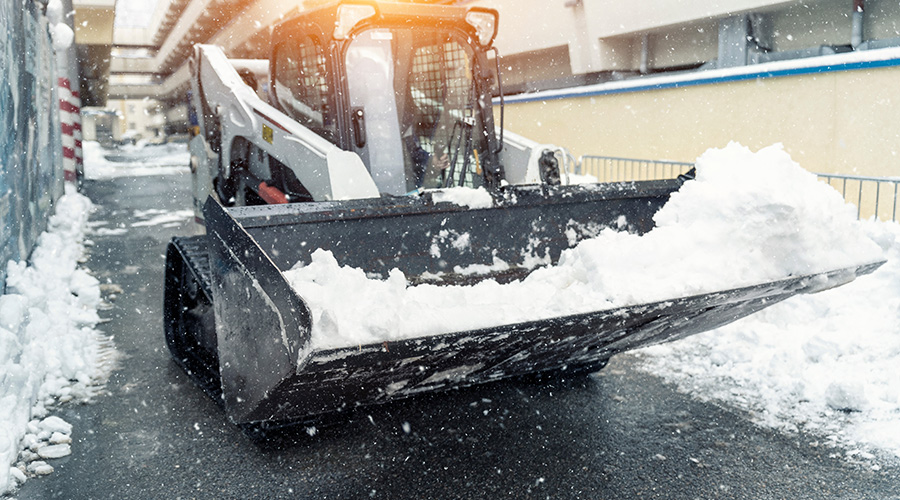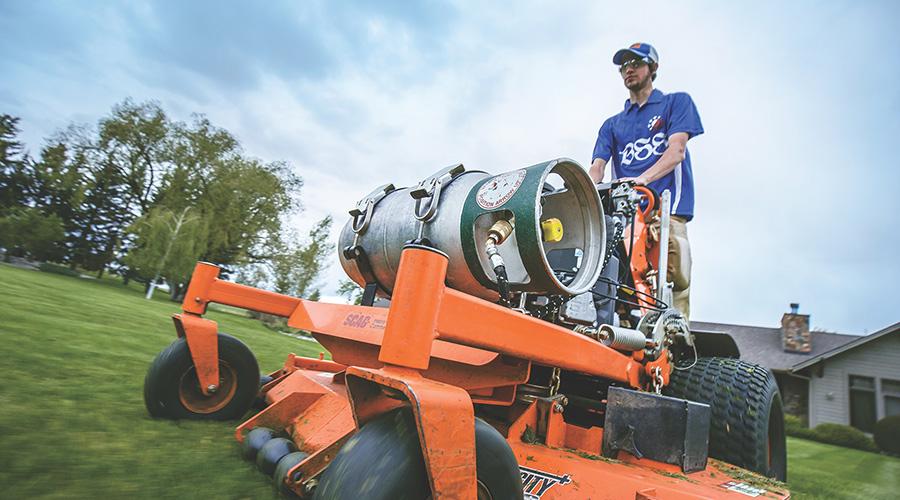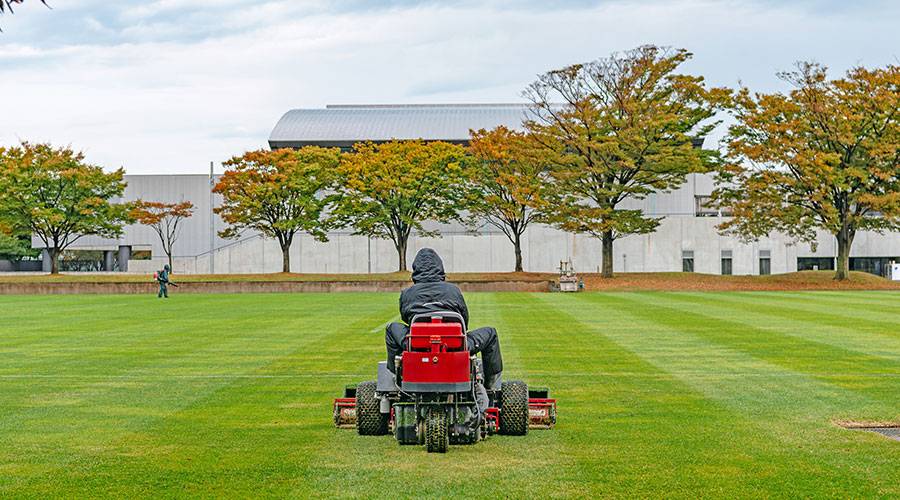The Dos and Don'ts of Safety
Guidelines for addressing training, personal protection and equipment inspection to create a culture of safety
Daily grounds care duties bring front-line workers into contact with numerous potential safety hazards. And the beginning of the busy season is the opportune time for grounds care managers to fine-tune their department’s program by reviewing these important dos and don’ts of grounds care safety.
Equipment Checks
Do make sure all vehicles and equipment are in proper working order and operating in a safe manner. Keeping all vehicles and equipment in proper working order is essential for safe operation. Attention and commitment to routine maintenance goes a long way to ensuring operator safety.
Items such as worn belts and brakes, loose bolts, faulty wiring, improper tire pressure, leaky spray nozzles and broken seat belts can attribute to injury in the workplace. Unsafe equipment and vehicles are not only a danger for the operator but also for bystanders in the area of operation.
Departments should use daily equipment and vehicle safety checklists.
“Before any piece of equipment is taken out, it should be checked to make sure it is in proper working order,” says Todd Cochran, assistant superintendent for Bergen County (N.J.) Department of Parks. “Just because the equipment worked fine yesterday doesn’t mean it is still OK today.”
Safety Overrides
Don’t allow employees to override safety features on equipment. It is not uncommon to see safety guards taken off line trimmers and shut-off handles taped up on mowers.
“These features were put on equipment for a reason,” says Kevin O’Donnell, superintendent of grounds for Villanova University. “Just like the safety stickers on equipment warning users of dangers, the safety features were not put on equipment because someone thinks injury may occur. Injuries have already happened.” O’Donnell manages 15 full-time grounds workers and oversees the grounds maintenance, fleet maintenance, trash collection and recycling at the 220-acre campus.
Each employee should receive training on safe equipment operation. Ellen Newell, landscape manager at Utah State University, says all department employees are trained on equipment before they are allowed to use it.
“In some cases, they must be tested to become certified before they can operate the vehicle or equipment,” she says.
Training consists of hands-on instruction and watching safety videos. Many manufacturers provide videos with their equipment.
“When we get a new piece of equipment, we bring in the sales representative to walk through proper operating procedures with the staff,” Cochran says. “We also make the operations manual available.” Safety training results in fewer injuries and accidents.
“Following safe operating procedures can really make an impact,” O’Donnell says. “We recently instituted a policy related to backing up vehicles. If there is a passenger in the vehicle, they must get out of the vehicle and direct the driver when backing up. This simple procedure has reduced accidents by more than 95 percent. It’s not that we had a lot of personal injuries related to backing up, but vehicle and property damage was costly.”
Unsafe Conditions
Don’t allow employees to work in unsafe conditions. Weather plays a big role in schedules and safety because much of the work to be done is outside. Mowing sloped wet ground, working outside in a thunderstorm or spraying pesticides on a windy day are not safe practices.
Bystanders
Don’t allow employees to operate mowers or line trimmers when people are nearby. Cochran says his department schedules mowing operations during off-peak times in the parks. Noon hours, after work, and weekends are times to schedule tasks that don’t interfere with activities or jeopardize the safety of the public. O’Donnell and Newell have similar concerns and do not plow snow or mow in between classes when there are masses of students outdoors.
Also, make sure mower operators do not work too close to each other. Serious accidents can result when the blade of the mower or line trimmer throws objects.
Personal Protection
Do provide, and require employees to wear, personal protective equipment at all times. Managers agree that providing and requiring proper safety gear is extremely important to ensuring safety in grounds care.
Ear and eye protection are two of the most underused safety products. Eye injuries are the most common type of on-the-job injury.
Cochran recalls an incident in which an employee was pulling a broken branch out of a tree when it snapped and jabbed him in the eye. The employee was off work for more than a year and had to undergo surgery.
“Ear and eye protection is required, not optional, for anyone operating a line trimmer,” O’Donnell says. “Hearing protection is also required for anyone using power equipment. We are becoming more aware of hearing loss due to constant exposure to loud noise.”
Chain-saw safety is often overlooked in grounds maintenance. In most operations, workers don’t use a chain saw often or for a very long time and can be lax regarding their use.
A common attitude is, “I’m just going to cut this one branch, I don’t need the gloves or chaps.” But that is usually when an accident occurs.
O’Donnell requires all chain saw users to wear chaps and thick, leather gloves when using a chain saw, even to cut just one branch.
Steel-toed boots are also an important personal safety item. O’Donnell recalls an incident in which he was working on a mower and it cut off the toes of his boots. If they were not steel-toed boots, the mower would have cut off his toes.
Pesticides
Do always use pesticides appropriately. Pesticide use can be potentially dangerous to the grounds care worker, the public and the environment. Newell requires all of her employees to become certified pesticide operators.
“This state certification requires completing a training coarse and passing the test,” Cochran says. It is extremely important that all staff members using pesticides know how to handle, store, apply and dispose of them properly. Cochran’s department has embraced an integrated pest management philosophy and uses pesticides minimally.
“In a public park environment, we need to be very sensitive of how the parks are being used,” he says. “People are sitting on the grass and walking barefoot.” There are a lot of animals and small children in the parks, too.
“Properly posting an area that has been treated with a pesticide is very important to public safety, and in many states, it’s the law,” he says. Make sure all employees are informed of right-to-know laws and know where material safety data sheets are located.
Training
Do provide initial and continual training. Initial safety training related to equipment, vehicle and pesticide use is a given. But continual training and reminders is also extremely important to ensuring safety in the workplace.
Newell says that his department’s safety officer puts up safety posters in the shop on a regular basis. Each poster has a different message, and by changing them weekly the employees tend to pay attention to them. The message doesn’t get stale.
O’Donnell stresses that training is not a cost but, instead, is an investment. A five-minute training session might save hours of lost time and wages, as well as hundreds or even thousands of dollars in insurance premiums and worker’s compensation, damage to equipment and serious personal injury or even death of a worker. Training should be done continually, he says. Accidents don’t wait to happen on a rainy day or during the slower time of year, so safety should be a priority every day.
“We mention a safety concern every day at our morning scheduling meeting,” O’Donnell says. “The whole meeting takes five minutes. We go over the day’s activities and safety concerns. It helps keep safety on everyone’s mind, even during the busiest times of the year.”
Monitor for Results
Do monitor workers to make sure they follow safety procedures. All the training, checklists and certifications don’t mean much if an employee still doesn’t follow proper procedures.
“Just after an incident, everyone is aware of and follows safety procedures, however after a few weeks they become lax again,” Cochran says. “As a responsible manager, you must investigate, get out in the field and check to make sure safety procedures are being followed. If they aren’t, action should be taken. Don’t wait for an incident to occur then start watching people.”
Involvement
Do get all employees involved in promoting safety. At Utah State University, all employees go through a safety-training program.
“It is a self-guided study course that everyone from the top down is taking,” Newell says. “The point of the seven-unit program is to get employees to speak up when they see unsafe practices or working conditions. We want everyone involved in and aware of safety issues, not ignoring them.”
Taking a positive approach to safety issues might be effective in preventing incidents.
“Giving employees incentives for safe behavior — so many incident-free days worked and discovery of unsafe conditions or procedures — may work well to make the workplace more safe,” Cochran says.
Managers shouldn’t assume anything about safety, such as knowing where utilities are buried, or that a new employee knows how to operate vehicles and equipment. Successful grounds care safety requires that managers lead by example. This approach includes not taking anything for granted in the daily tasks of grounds care.
Related Topics:











